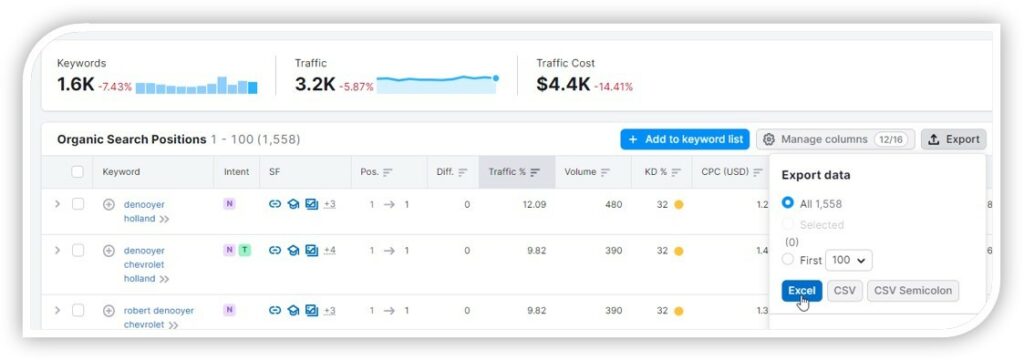According to data compiled by Reputation 911, only 4.8% of searchers click-through to the second page of search results, so the first page is where you will thrive. By trying to move your website from SERPs page 2 to page 1, you will make your goals attainable. So, with a clearly defined goal, let’s walk through how we get there.
The first thing to do is choose Top Keyword Phrases that internet shoppers in our target market most often use in searches. Second, choose phrases for which your website is ranking on Page Two of the Search Engine Results Pages (SERPs), with the goal of moving your website to Page One. Finally, tender your strategy with an eye on the Keyword Difficulty (KD) for the phrase. KD is the internet’s way of measuring the strength of other websites already ranking for this keyword phrase and, therefore, the difficulty you will have to improve your ranking against them on a scale of 1 to 100. If you choose keywords with a KD of 75, it might feel like swimming against a river current, but if you choose a KD of 100, it might feel like you are trying to climb straight up a heavily flowing waterfall with a backpack on.
For a strategic approach on where to focus our efforts, we need to develop a Keyword Phrase Target list. For this research, I use the Top Organic Keywords Report in Semrush. This report is a complete listing of all organic keyword phrases your website ranks for in the market you select. To get there, navigate to Semrush, enter your URL in the Domain Overview tab on the left vertical link list, and filter for your market (I like to use the U.S. market). Then scroll down to Top Organic Keywords and click “View Details.” Now you can click the Export button on the right, download it, and open it with Excel.

Opening this report initially you’ll notice a dizzying amount of data, and looking at it all could make you feel light-headed. I recommend going into edit mode and deleting columns F through P and focusing on columns A through E:
- Your website’s entire keyword phrase list
- Your website’s current ranking position
- Your website’s previous position
- The overall search volume for this phrase in your market
- The Keyword Difficulty KD
Highlight columns A-E, spread them out, and center the data. It’s now easier to read. My example screenshot above shows 1,600 keyword rows on this example report. Next, let’s set up some filters to help us focus on specific data. With the columns still highlighted, you can click Sort and Filter / Filter, which will add a drop-down arrow at the top of each column to allow you to sort. Now we are ready to get to work.

Developing a Target Keyword Phrase List
There are many ways to analyze data. I like to break it into steps. The first step is to sort by selecting the Search Volume column (D) and filter from Largest to Smallest. At the top of your report, you now have the phrases your website ranks for, which are the most often searched in your market. You can now compare the highest ranked searched terms to your current position and keep an eye on that KD to develop a list of target phrases you want to go after.
If your website is ranking in the 11th position, then you are on the cusp of moving to SERPs page 1. If the phrase is getting 9,900 searches per month in your market, then even if you were on the bottom of the first SERPs page and only garnering 5% of the clicks for it, that’s 495 clicks which is not bad. If the KD is only 60 then this keyword phrase might have the right combination of the highest value, the smallest distance to move, and only a moderate amount of lift to get there.
Next, select the Position filter (B) and stack smallest to largest. Of course, your website ranks in the first position for your business name and physical location. Ranking for branded terms is not a focus for the savvy SEO Strategist because your website naturally ranks #1 for these. Let’s scroll down to position #11. This is where you appear on page 2 of the SERPs, but you are on the cusp of page 1. Now you can compare your position to its overall search volume and keep a side eye on that KD. If you are ranking #12, the search volume is 880, and the KD is only 55, then this is a fantastic target and a place to focus your efforts. Let’s add this phrase to your Target Phrase list.
After you develop your list of Target Keyword phrases, it’s time to add them to the rich textual copy on your website. Try to add them to H1 tags and as navigation drop-down menu items when feasible, as these have higher ranking authority in Google. After you publish, you can get a jump start on the indexing using Google Search Console and the URL Inspection Tool to Request Indexing for the page. This will place your newly published page in a priority queue for crawling. Now that you are published and indexed, over the following months you can pull a fresh Keyword Report from Semrush to see how your positions have changed.

